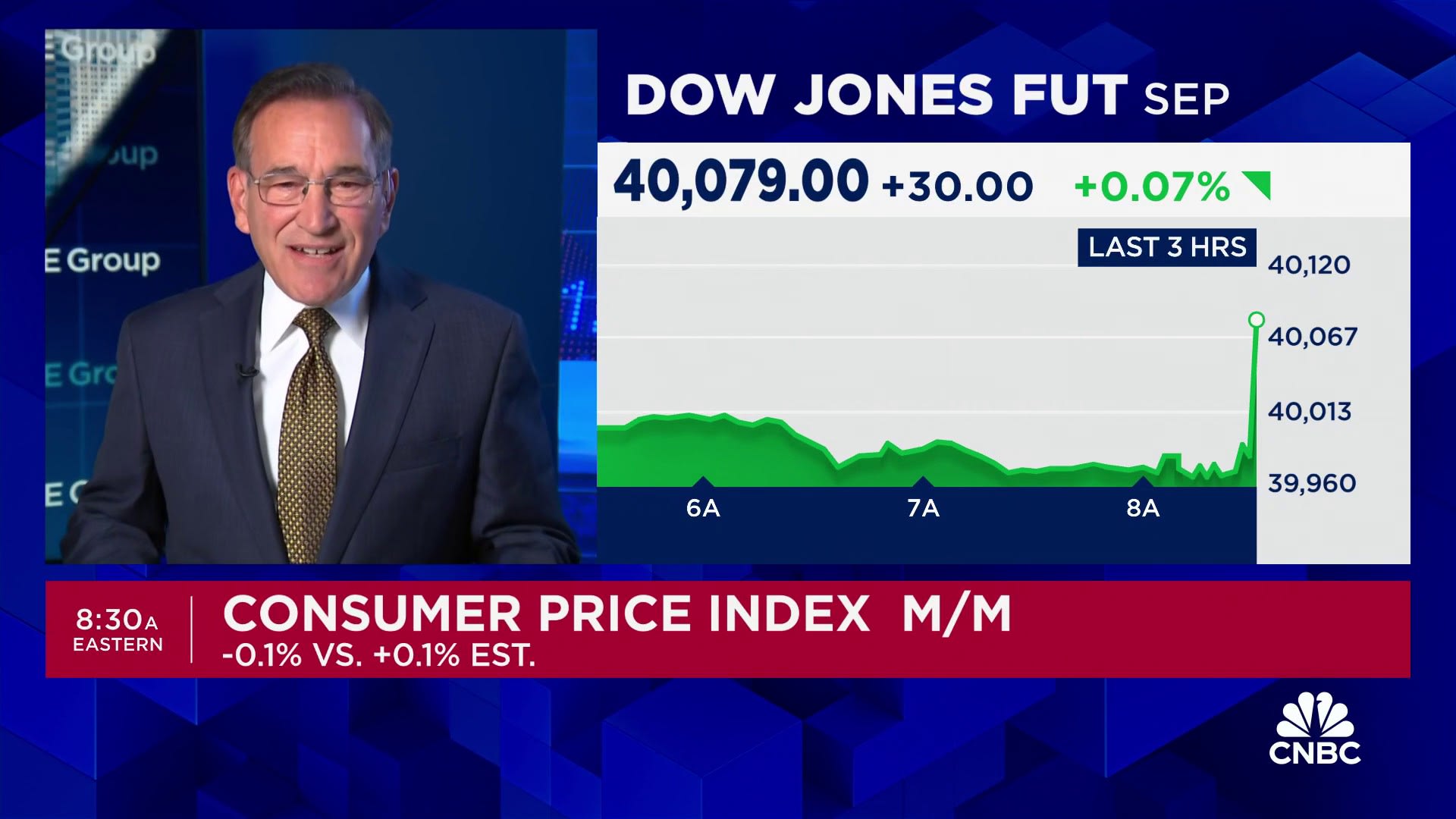David Paul Morris/Bloomberg via Getty Images
Inflation fell further in June as lower gasoline prices combined with other easing price pressures to bring relief for consumers’ wallets.
The consumer price index, a key inflation gauge, rose 3% in June from a year ago, down from 3.3% in May, the U.S. Labor Department reported Thursday.
The CPI gauges how fast prices are changing across the U.S. economy. It measures everything from fruits and vegetables to haircuts, concert tickets and household appliances.
Perhaps the “most encouraging” news for consumers is that inflation for household necessities has cooled dramatically, said Mark Zandi, chief economist at Moody’s Analytics.
“The prices for staples — food at home, gasoline, new-lease rents — they haven’t changed in about a year,” Zandi said. “So people are paying the same for those staples today that they were a year ago.”
The April inflation reading is down significantly from its 9.1% pandemic-era peak in 2022, which was the highest level since 1981.
However, it remains above policymakers’ long-term target, around 2%.
“We continue to expect inflation to grind lower in the months ahead as input cost pressures ease and more tepid consumer demand makes it harder [for businesses] to raise prices,” Sarah House and Aubrey George, economists at Wells Fargo Economics, wrote in a note this week.
However, additional improvements are likely to be “slow-going,” they wrote.
Good sign for Fed interest rate cut in September
The U.S. Federal Reserve uses inflation data to help guide its interest-rate policy. It raised interest rates to their highest level in 23 years during the pandemic era, pushing up borrowing costs for consumers and businesses in a bid to tame inflation.
Last month, Fed officials forecast they’d start cutting rates by the end of 2024.
“All indications are inflation has moderated, is back close to the Fed’s target and consistent with a rate cut in September,” Zandi said.
Gasoline prices weigh on inflation

There’s also been a broad pullback in prices at the grocery store.
“Food at home” prices have risen by just 1.1% since June 2023, according to CPI data.
Consumers have more “breathing room” at the store amid “growing promotional activity” among retailers, while a few “major” companies recently announced price cuts “that are likely to pressure competitors’ pricing,” wrote economists House and George.
‘Core’ CPI at lowest level in three years
While annual data on inflation trends is helpful, economists generally recommend looking at monthly numbers as a better guide of short-term movements and prevailing trends.
They also generally like to examine “core” inflation readings. They strip out food and energy prices, which can be volatile from month to month.
The monthly core CPI reading was 0.1% in June, the smallest increase in about three years, since August 2021. It has declined for three consecutive months, from 0.4% in March. (To get back to target, economists say the monthly reading should consistently be in the range of about 0.2%.)
“Core” CPI has risen 3.3% since June 2023, the smallest 12-month gain since April 2021.
Housing is the largest component of core CPI and therefore has an outsized impact on inflation readings. It has accounted for nearly 70% of the total 12-month increase in core CPI.
Shelter inflation has moderated much slower than expected, one of the big reasons inflation hasn’t yet fallen back to target, economists said.
The shelter index lags broader trends in the rental market due to how the government constructs it.
However, economists expect shelter to throttle back further since inflation for market rents has plummeted. For example, the annual inflation rate for new rental contracts sunk to 0.4% in the first quarter of 2024 — lower than its pre-pandemic baseline — from record highs of around 12% just two years earlier, according to Bureau of Labor Statistics data.
There were encouraging signals in the latest CPI report: Monthly shelter inflation dropped to 0.2% after being stuck at 0.4% for four consecutive months. It was the smallest monthly gain since August 2021.
“It should continue to cool off,” said Joe Seydl, senior markets economist at J.P. Morgan Private Bank.
“It just takes time,” he added.
Services inflation is the trouble spot
Inflation for physical goods spiked as the U.S. economy reopened in 2021. The Covid-19 pandemic disrupted supply chains, while Americans spent more on their homes and less on services such as dining out and entertainment.
It’s a different story now. Goods inflation has largely normalized while services is a fly in the ointment.
“The goods side looks very benign at the moment,” said Olivia Cross, a North America economist at Capital Economics. “Where there’s work to be done is in some areas of core services and in shelter.”
For example, prices for services like motor vehicle insurance and medical care jumped a “notable” 19.5% and 3.3% since June 2023, respectively, the BLS said.
The prices for staples — food at home, gasoline, new-lease rents — they haven’t changed in about a year.
Mark Zandi
chief economist at Moody’s Analytics
A surge in new and used car prices a few years ago is likely now fueling high inflation for car insurance and repair, since it generally costs more to insure and repair pricier cars, economists said.
It also takes a long time — a year, two or even three — for higher labor costs in healthcare to translate to CPI readings due to a long contracting process, Zandi said. Higher pandemic-era wages in healthcare are now nudging up medical care CPI and will likely do so over the coming year, he said.

The services sector is generally more sensitive to inflationary pressures in the labor market such as strong wage growth.
Record-high demand for workers as the pandemic-era economy reopened pushed wage growth to its highest level in decades. The labor market has since cooled and wage growth has declined, though it remains above its pre-pandemic level.
“Inflationary pressure from the labor market has dissipated quite strongly,” Cross said.

